
CupInfo Home | 2024 Results: RR1 | Schedule | Previous Events | Feature Articles | Books | CupStats
Welcome to
CupStats!
2013 America's Cup Match: CupStats Home
On this page (click or scroll down):
America's Cup 2013 - ETNZ vs. Oracle Team USA:
Race 17-18 Polars: Speed Over Ground (SOG) | Velocity Made Good (VMG)
Race 16 Polars: Speed Over Ground (SOG) | Velocity Made Good (VMG)
Race 14-15 Polars: Speed Over Ground (SOG) | Velocity Made Good (VMG)
Race 13 Polars: Speed Over Ground (SOG) | Velocity Made Good (VMG)
Race 12 Polars: Speed Over Ground (SOG) | Velocity Made Good (VMG)
Race 11 Polars: Speed Over Ground (SOG) | Velocity Made Good (VMG)
Race 10 Polars: Speed Over Ground (SOG) | Velocity Made Good (VMG)
Race 9 Polars: Speed Over Ground (SOG) | Velocity Made Good (VMG)
Race 8 Polars: Speed Over Ground (SOG) | Velocity Made Good (VMG)
Race 7 Polars: Speed Over Ground (SOG) | Velocity Made Good (VMG)
Race 6 Polars: Speed Over Ground (SOG) | Velocity Made Good (VMG)
Race 5 Polars: Speed Over Ground (SOG) | Velocity Made Good (VMG)
Race 3-4 Polars: Speed Over Ground (SOG) | Velocity Made Good (VMG)
Also see: Race 1-2 Polars
Polar Plots Races 17-18 for Emirates Team New Zealand vs. Oracle Team USA:
SOG: Average
Speed-Over-Ground (SOG) at True-Wind

See Races 3-4 for explanation of polar plots.
VMG: Velocity
Made Good (VMG) at True-Wind-Angle (TWA):
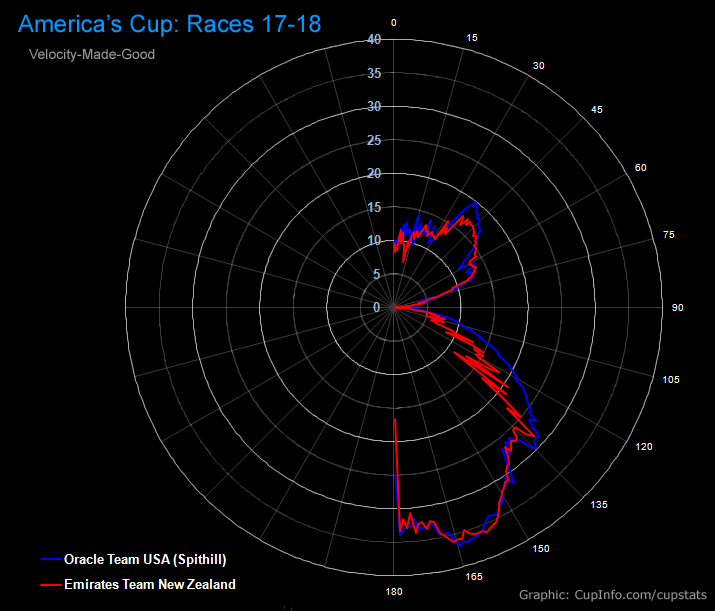
See Races 3-4 for explanation of polar plots.
Polar Plots Race 16 for Emirates Team New
Zealand vs. Oracle Team USA:
SOG: Average
Speed-Over-Ground (SOG) at True-Wind
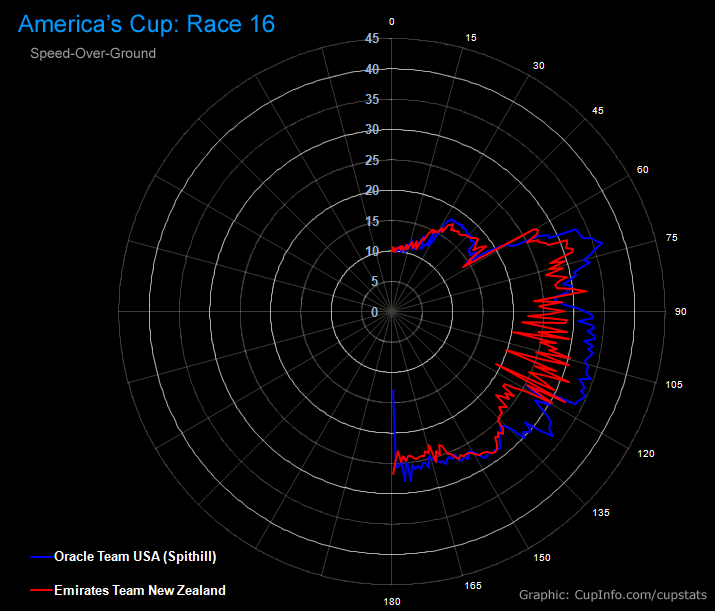
See Races 3-4 for explanation of polar plots.
VMG: Velocity Made
Good (VMG) at True-Wind-Angle (TWA):

See Races 3-4 for explanation of polar plots.
Polar Plots Races 14-15 for Emirates Team New
Zealand vs. Oracle Team USA:
SOG: Average
Speed-Over-Ground (SOG) at True-Wind
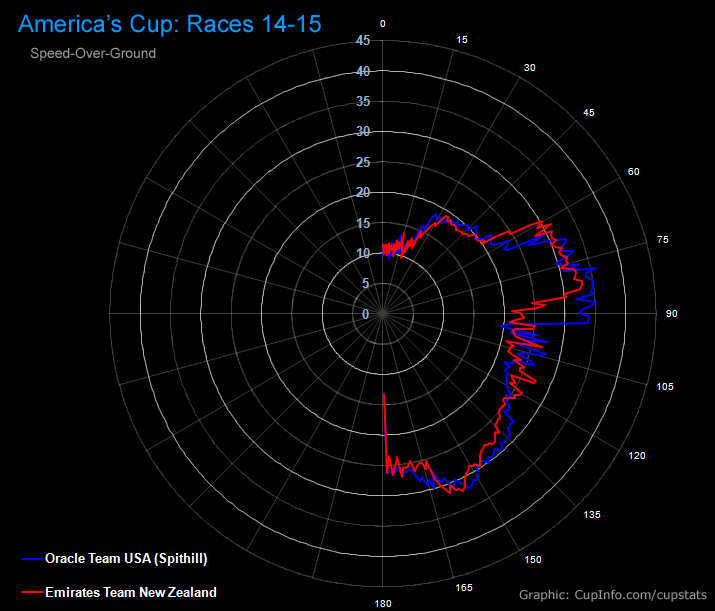
See Races 3-4 for explanation of polar plots.
VMG: Velocity
Made Good (VMG) at True-Wind-Angle (TWA):
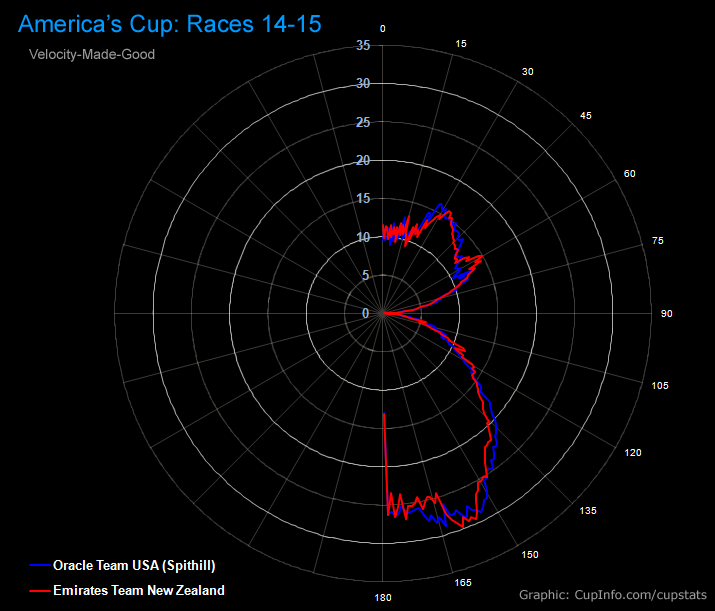
See Races 3-4 for explanation of polar plots.
Polar Plots Race 13 for Emirates Team New
Zealand vs. Oracle Team USA:
SOG: Average
Speed-Over-Ground (SOG) at True-Wind
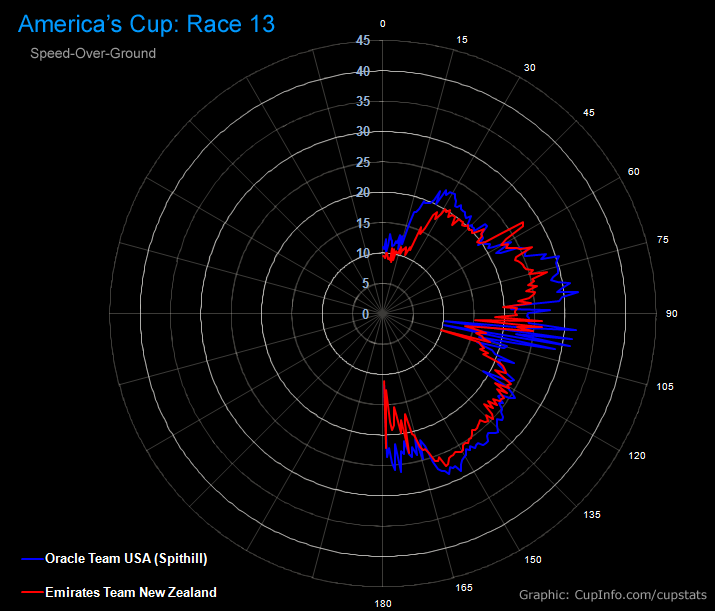
See Races 3-4 for explanation of polar plots.
VMG: Velocity Made
Good (VMG) at True-Wind-Angle (TWA):
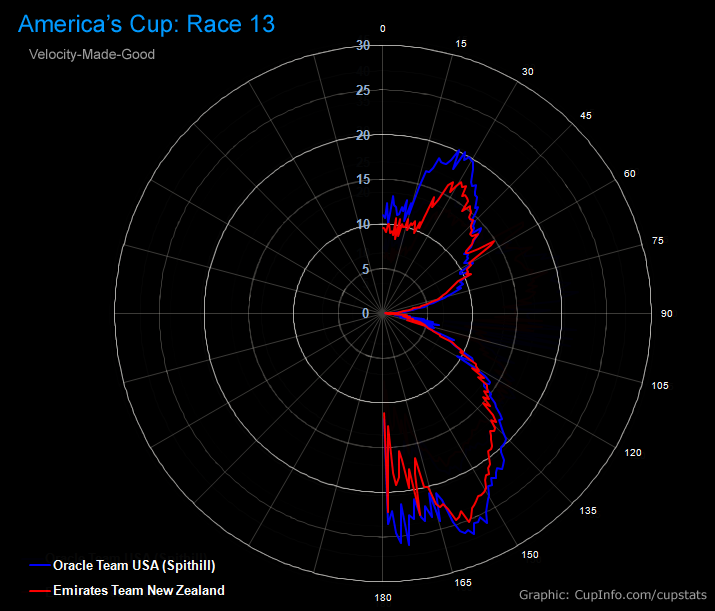
See Races 3-4 for explanation of polar plots.
Polar Plots Race 12 for Emirates Team New
Zealand vs. Oracle Team USA:
SOG: Average
Speed-Over-Ground (SOG) at True-Wind
See Races 3-4 for explanation of polar plots.
VMG: Velocity Made
Good (VMG) at True-Wind-Angle (TWA):
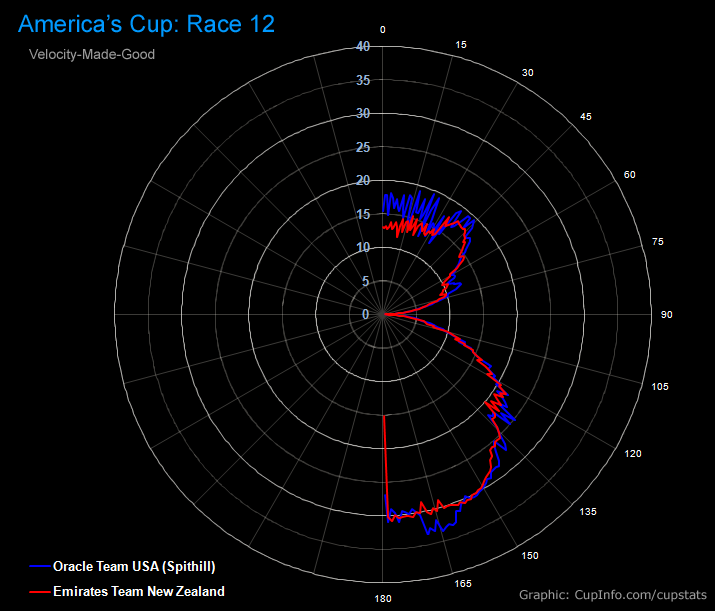
See Races 3-4 for explanation of polar plots.
Polar Plots Race 11 for Emirates Team New
Zealand vs. Oracle Team USA:
SOG: Average Speed-Over-Ground (SOG) at True-Wind
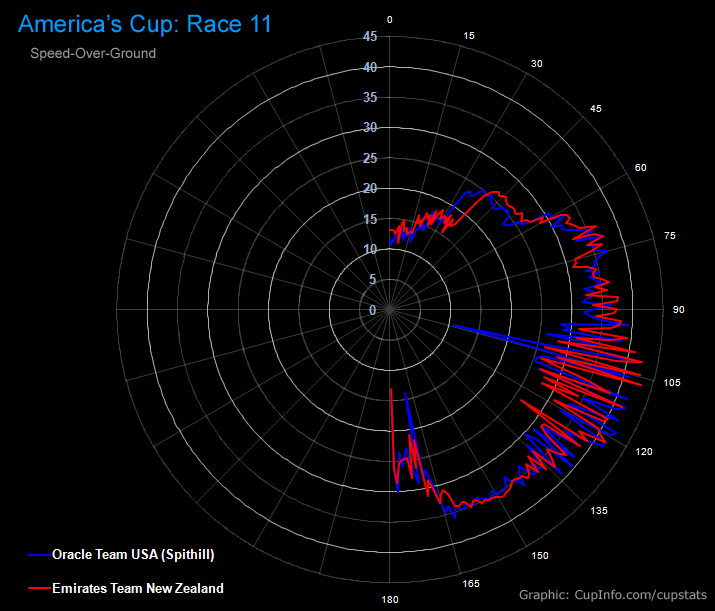
How does the plot work? See Races 3-4 for explanation of
polar plots.
VMG: Velocity Made
Good (VMG) at True-Wind-Angle (TWA):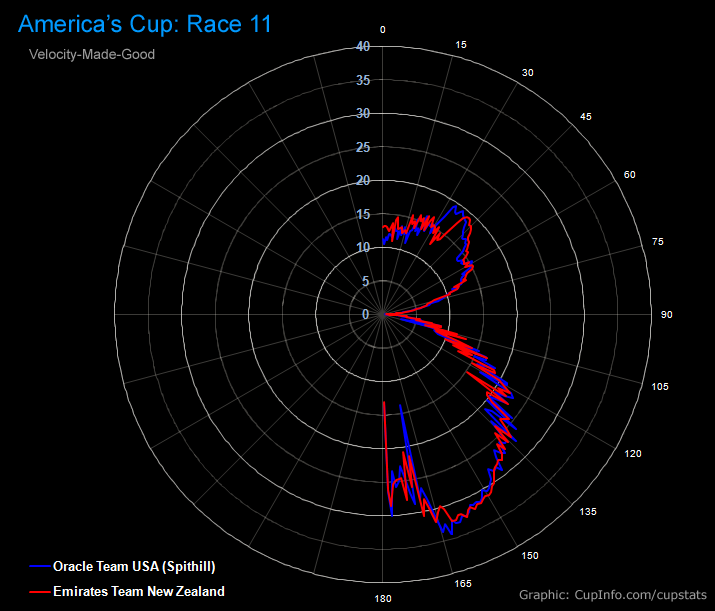
How does the plot work? See Races 3-4 for explanation of
polar plots.
Polar Plots Race 10 for Emirates Team New Zealand vs. Oracle Team USA:
SOG: Average
Speed-Over-Ground (SOG) at True-Wind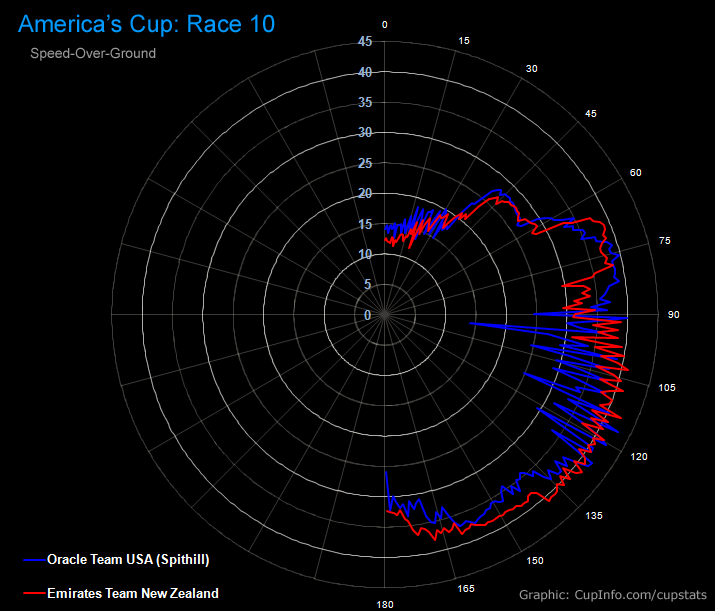
How does the plot work? See Races 3-4 for explanation of
polar plots.
VMG: Velocity Made
Good (VMG) at True-Wind-Angle (TWA):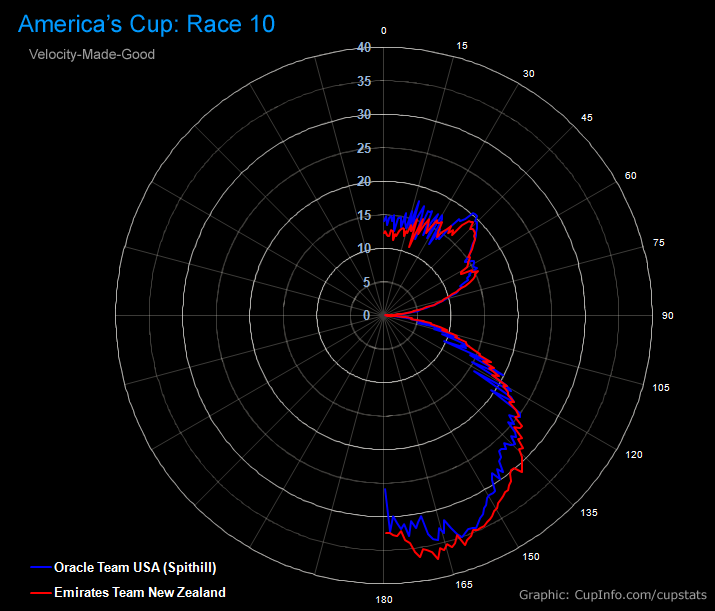
How does the plot work? See Races 3-4 for explanation of
polar plots.
Polar Plots Race 9 for Emirates Team New Zealand vs. Oracle Team USA:
SOG: Average
Speed-Over-Ground (SOG) at True-Wind

How does the plot work? See Races 3-4 for explanation of polar plots.
VMG: Velocity Made
Good (VMG) at True-Wind-Angle (TWA):
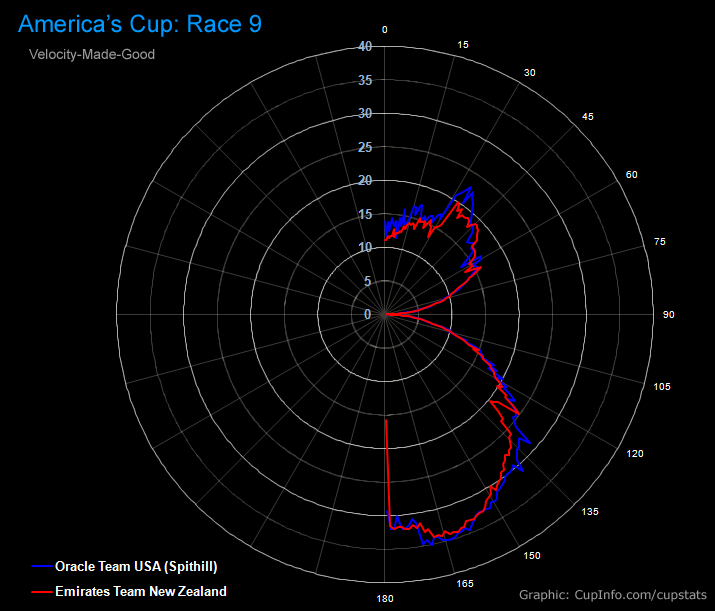
How does the plot work? See Races 3-4 for explanation of polar plots.
Polar Plots Race 8 for Emirates Team New Zealand vs. Oracle Team USA:
SOG: Average Speed-Over-Ground (SOG) at True-Wind
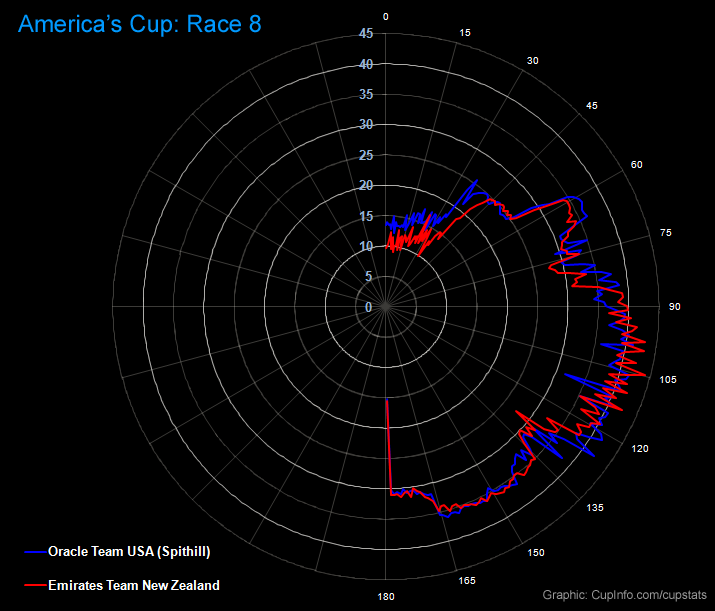
How does the plot work? See Races 3-4 for explanation of
polar plots.
VMG: Velocity Made Good (VMG) at True-Wind-Angle (TWA):
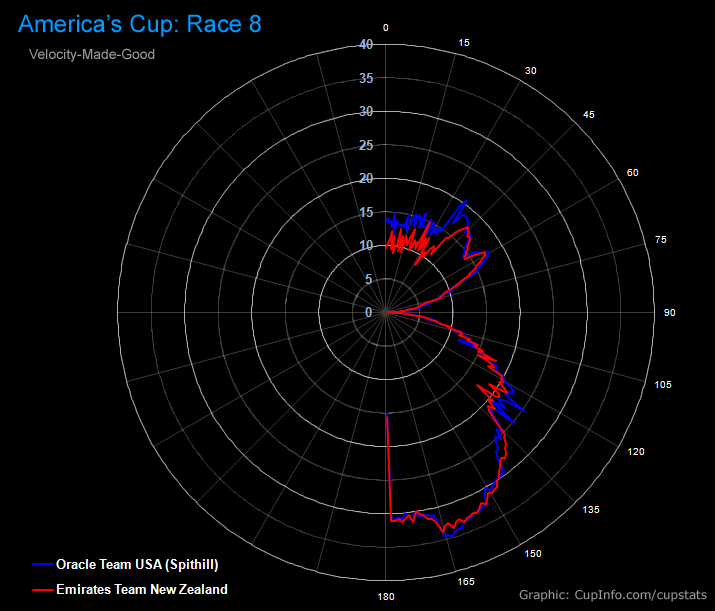
How does the plot work? See Races 3-4 for explanation of
polar plots.
Polar Plots Race 7 for Emirates Team New Zealand vs. Oracle Team USA:
SOG: Average Speed-Over-Ground (SOG) at True-Wind-Angle (TWA)

How does the plot work? See Races 3-4 for explanation of
polar plots.
Also: See Race 7 Wind Distribution
VMG: Velocity Made Good (VMG) at True-Wind-Angle (TWA):
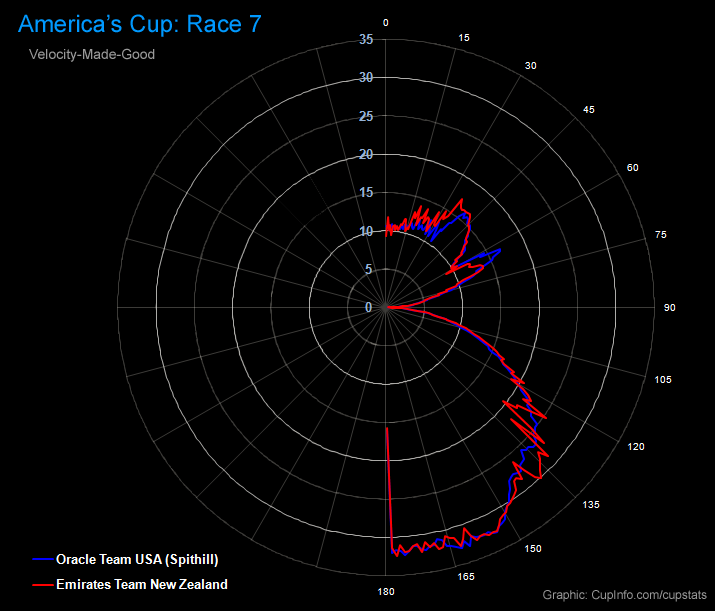
How does the plot work? See Races 3-4 for explanation of polar plots.
Also: See Race 7 Wind Distribution
Polar Plots Race 6 for Emirates Team New Zealand vs. Oracle Team USA:
SOG: Average Speed-Over-Ground (SOG) at True-Wind-Angle (TWA)

How does the plot work? See Races 3-4 for explanation of polar plots.
What does the plot show about Race 6?
Starting at the bottom:
(180 degrees to 160 degrees): Speeds through gybes were comparable.
160 to 140 degrees: The boats seem even matched downwind in these conditions.
Winds were lighter in Race 6 than in most of the match.
135 to 70 degrees: Most of the data on this leg comes from the short
reaching leg (Leg 1).
40 to 25 degrees: This is the prime upwind zone. As pointing angle
increases, nearing 40 degrees, USA's speed falls off sooner and further.
NZL is pointing better. Compare to Race 6 VMG below.
Under 30 degrees: NZL is sustaining noticeably higher speeds through the gybes
now.
Also: See Race 6 Wind Distribution
VMG: Velocity Made
Good (VMG) at True-Wind-Angle (TWA):
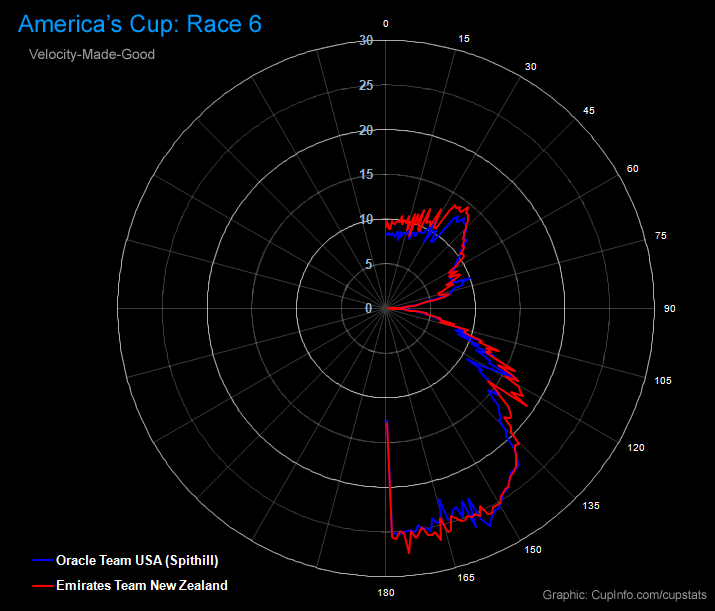
See Races 3-4 for explanation of polar plots.
The key area to note on the Race 6 VMG Polar is the 30-45 degree range. Upwind the boats typically sail much of the time at angles near 40 degrees. NZL has a significant advantage in these conditions in her speed and ability to point upwind just slightly better than USA. When pointing angles increase toward the mid-40s, that advantage fades away.
Polar Plots Race 5 for Emirates Team New Zealand vs. Oracle Team USA:
SOG: Average
Speed-Over-Ground (SOG) at True-Wind-Angle (TWA)
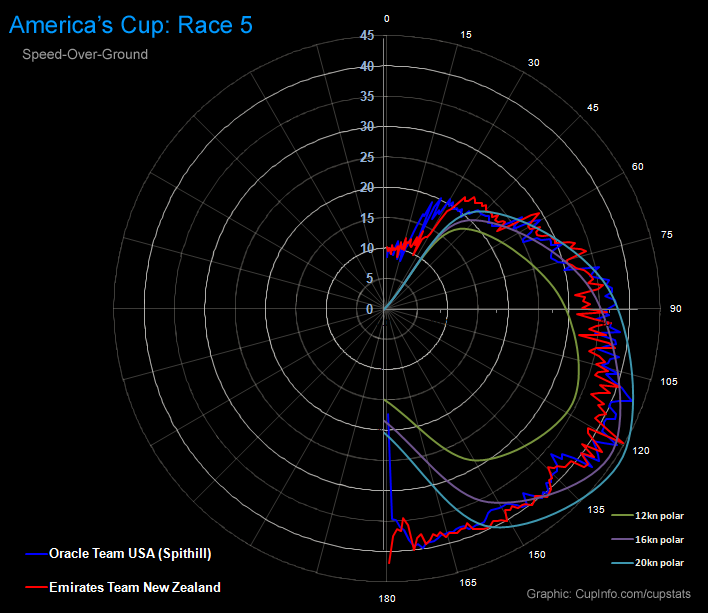
See Races 3-4 below for explanation of polar plots.
Also: See Race 5 Wind Distribution
VMG: Velocity Made
Good (VMG) at True-Wind-Angle (TWA):
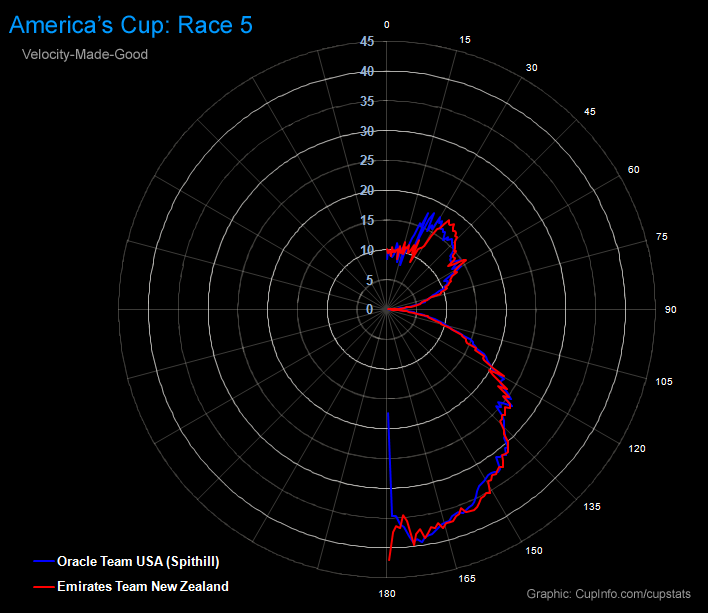
See Races 3-4 below for explanation of polar plots.
Polar Plots R3-R4 for Emirates Team New Zealand vs. Oracle Team USA:
SOG: Average
Speed-Over-Ground (SOG) at True-Wind-Angle (TWA)
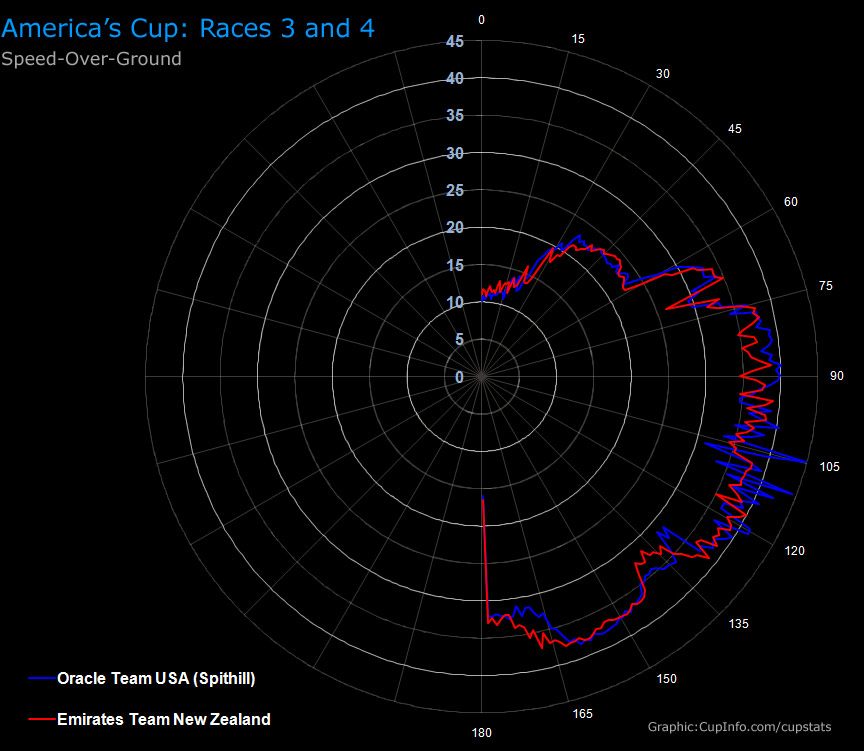
Explanation:
The plot above shows simple average boat speed at true wind angles based on
Races 3 and 4 of the 2013 America's Cup Final. Boat speed in knots is
plotted as distance from the center (marked in the blue numbers) and true wind
angle is plotted as degrees from the vertical (marked in the white numbers).
Zero degrees, straight up on the plot, is straight into the wind. 180 degrees,
straight down on the plot, is directly downwind.
Oracle is plotted in Blue and Emirates in red. The plots for each boat are over the average wind speeds experienced on the course, which for much of the race were effectively the same.
The reaching leg (in the 90 degree range) is the first short leg of the course. The primary areas of interest lie near the most typical upwind angles (in the 40 degree range) and typical downwind angles (near 150 degrees).
The plots of the race yachts are not a true polar showing potential boat speed, but actual data collected at the angles shown. For example the speeds at direct downwind angles were recorded during jibes and the direct upwind angles recorded during tacks. Reaching angles, close to 90 degrees, would generally be sailed on the first leg of the race and thus also be influenced by the nature of the competition in that sort period of time. As such they are a comparison of maneuvering and other competitive factors between the boats rather than just maximum speed on any given point of sail.
Since these are plots of the actual data points, as a visual clue the smoothest portions of the lines are the regions with the largest number of points available, and less likely to be influenced by unusual behavior or random factors.
The data for the reaching angles in Races 3 and 4 will be even more skewed because USA used tactics to hold NZL to a higher and pushed them beyond the reaching mark, a change from previous races where NZL sailed a lower course down onto USA, disturbing their wind, and dropping in front of them.
Analysis:
NZL did not display the same speed advantage in Races 3-4 that they showed in
Races 1-2. Whether it's rudder
elevator angle or something else, NZL little to no speed margin upwind in the
average polars, sometimes negative, compared to USA. Speeds through tacks
were much closer in Race 3 and 4, too, without the clear gap between the
Defender and Challenger seen on Saturday. Oracle Skipper James Spithill
still said Monday would include practice aimed at improving tacking efficiency.
Downwind speeds are about dead even in Races 3 and 4, again a change from Races 1-2 where NZL showed a small but visible advantage in the numbers, though the boats seemed nearly identical in those races.
Faster tacks may also be helping the improved upwind average speeds, and in any case, it's not easily to define whether the smaller margin is a USA improvement or an NZL slip. Both teams are tuning and tweaking their configurations, balancing strengths and weaknesses across the modes. The America's Cup is so typically a game of improvement as well as execution, even at this late point in the regatta, and especially on these boats.
It's a fair caveat that there are factors where a leading boat sails in better air going to windward, and generally can use their advantage to set up for more efficient mark roundings and maneuvers. These plots are visual evidence of a closer race on most points of sail, but can't by themselves reveal the causes for the differences. They can be a useful bit of evidence in a wider exploration of the match-up.
Still, the numbers show that the upwind advantage for ETNZ that nearly all sides were ready to concede on Saturday doesn't show up strongly in the average performance numbers analyzed here. It's especially interesting when the factor of increasing wind strength in Race 4 is considered in light of the potential for even higher winds for Tuesday's racing. Who has the upper hand in the 20-knot-plus wind range?
Also: See Races 3-4 Wind Distribution
ETNZ-Oracle Team USA Races 3-4:
VMG: Velocity Made Good (VMG)
at True-Wind-Angle (TWA):
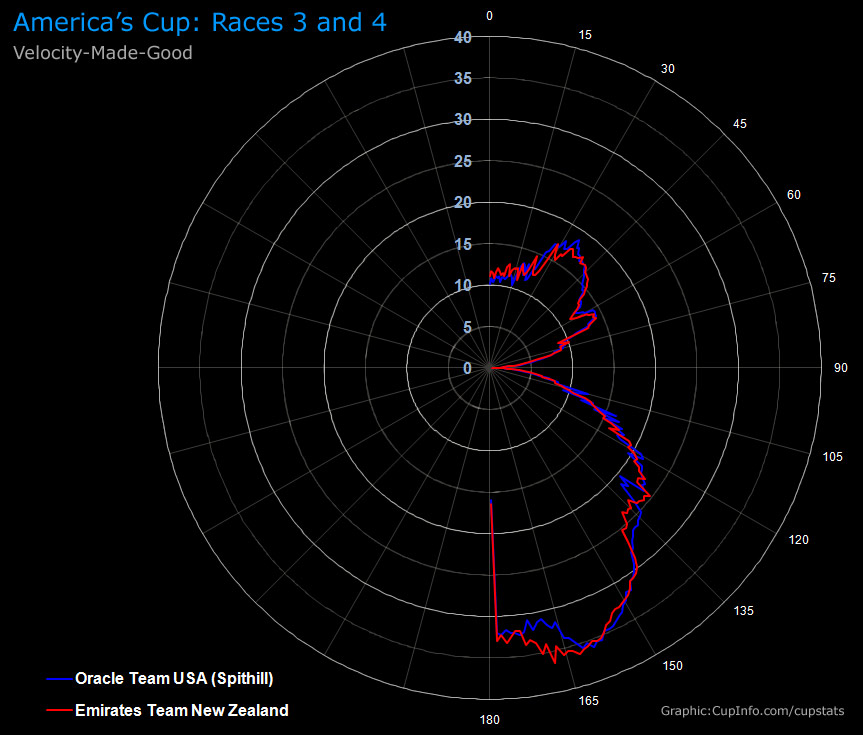
Velocity Made Good (VMG) is calculated in this case as the direct upwind or downwind component of velocity, depending on leg of the race course.
The reaching leg (in the 90 degree range) is obviously not revealing as all speeds approach zero VMG under this definition as they reach exactly 90. The primary areas of interest lie near the most typical upwind angles (in the 40 degree range) and typical downwind angles (near 150 degrees).
Analysis:
USA is tending to show even or better downwind and upwind VMG speeds in Race 3
and 4, a clear change from the previous two
races where they trailed slightly but consistently in both.
2013 Louis Vuitton Cup: Louis Vuitton Cup Stats | LVC Results
Previous Event Stats: 2007 America's Cup & Louis Vuitton Cup
Inquiries please contact: